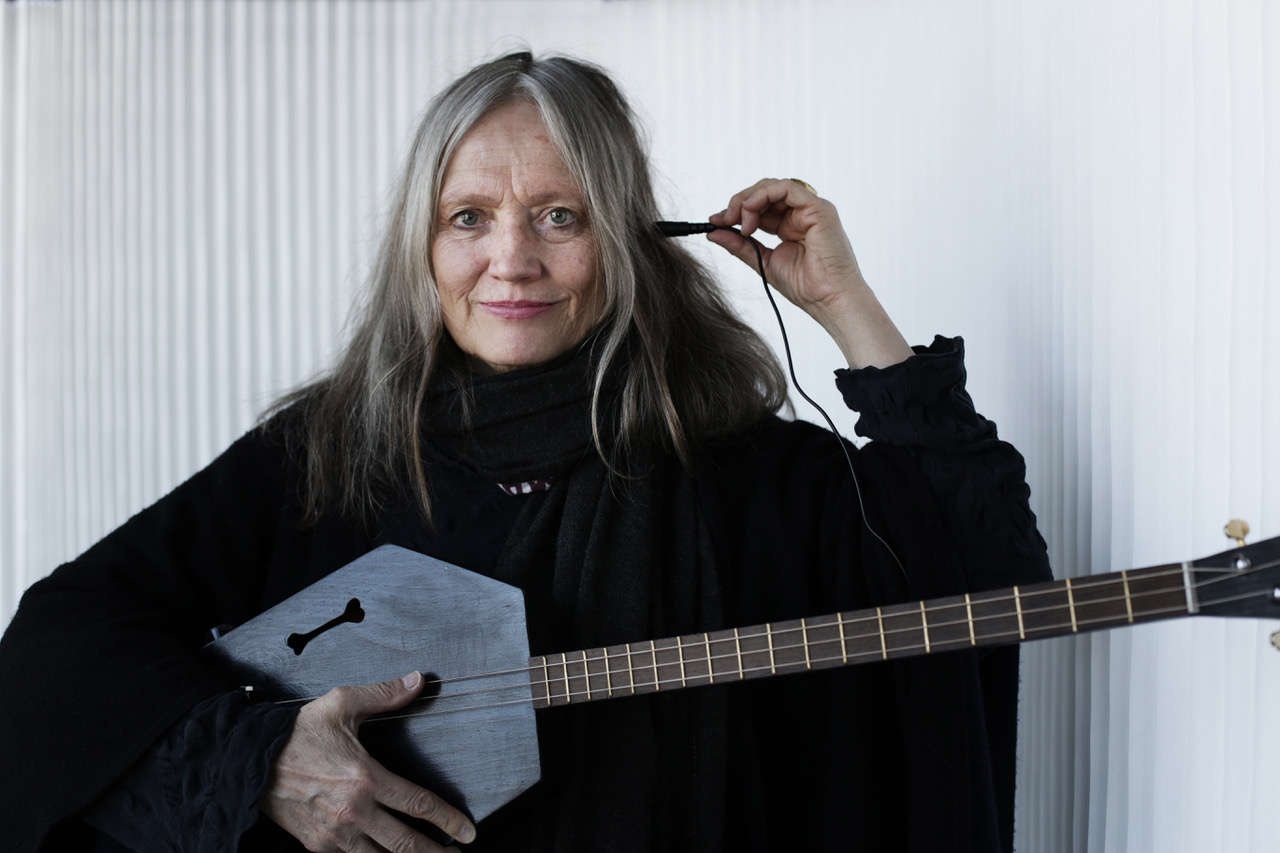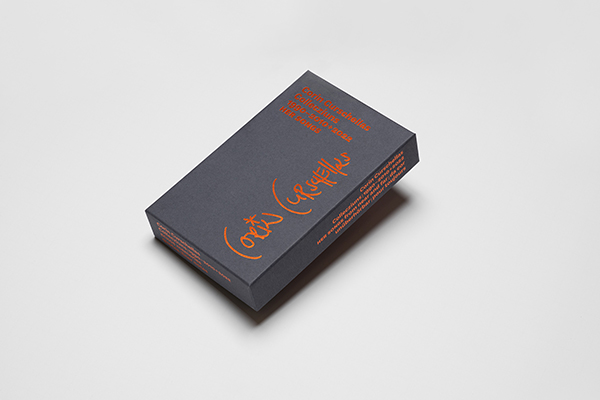Corin Curschellas performed live for the first time 50 years ago and soon revealed her versatile talents. An extraordinary retrospective now provides a new look at a creative phase of the Graubünden singer, multi-instrumentalist, songwriter and actress.
Anyone releasing a 4-CD box set in an age of streaming, playlists and TikTok needs good reasons to do so. The Tourbo Music label has found them and presents an exceptional box set with “Collecziuns: Her Songs 1990-2010+2022”. In addition to the four CDs, the carefully crafted box also contains two stylishly designed booklets illustrated with beautiful photos containing all the song lyrics, liner notes and tributes from 26 personalities.
We were fascinated by this beautifully realized collection and had a talk with Clemens Schedler from Bureau für konktrete Gestaltung in Vienna, who was in charge for the Design, in order to find out all about it.
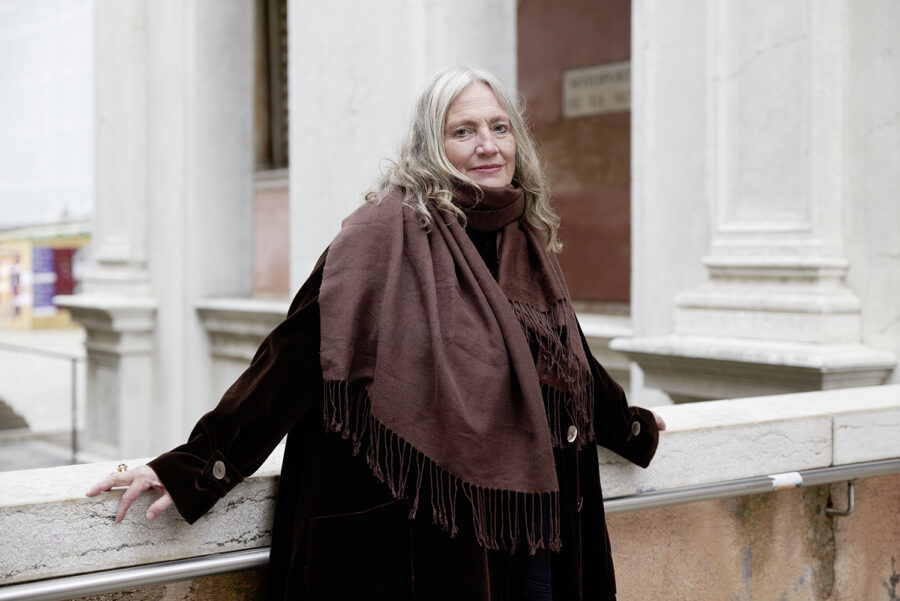
Concept & Design: what was behind choosing the color pallet, the design of the books? What can you share regarding the story of the project?
Corin Curschellas, born in 1956 in Chur [Graubünden, Switzerland], spent more than thirty years moving in the international waters and contemporary currents of jazz in the broadest sense. She lived in Zurich, Berlin, Barcelona, London, Vienna, Paris and New York before emigrating back to Switzerland around 15 years ago. We had known each other for several years through mutual friends. Out of respect for her personality and her specific musical and artistic weight, I approached her rather cautiously, even a little shyly. My joy flickered all the more enthusiastically when Corin asked me to design a retrospective of 60 songs on 4 CDs to mark her fiftieth stage anniversary.
I do not see myself as an artist, but as an applied designer and, above all, as an attentive craftsman. I don’t want to add my own will to form or design to my work. I explore and listen to what is already there in terms of content, stories, contexts and developments, texts and images. From this, an appropriate and, above all, coherent unity of “content and form” usually unfolds quite naturally.
I do not see myself as an artist, but as an applied designer and, above all, as an attentive craftsman.
Our concrete collaboration therefore began with days spent together. I visited Corin Curschellas in her studio in Rueun, immersed myself in her biographical topography, in her personal, artistic and musical universe. We rummaged together through her archives, through folders and boxes [treasure chests] full of memories in photographs and slides. We wandered together through lifetimes, documents, memories, goddesses and the world. On one of the cupboards, I noticed stacks of square stretcher frames – meditative paintings from the COVID lockdown times. Corin calls them “Endless Pulsations” and waved them off, but I insisted that we look at these seventy or so pictures together. From the dozen we selected, the four “finalists” ended up as the front covers of the CD sleeves/cardboard pockets…

The 60 songs on four CDs were set. Mathias Rüegg curated the selection and order, as well as the naming of this “lifetime legacy” [Peter Rüedi, Germanist and music journalist].
It was also clear that we did not want an industrial multibox, that standardized plastic container with inserted, wire-stapled or glue-bound brochures in miniature format.
The four CDs were manufactured industrially in a simple cardboard sleeve. The 60 song lyrics in Rumantsch [Rhaeto-Romanic], Swiss dialect, German, English and French were used to create the 208-page book »HER SONGS — from near and far | da cor | unüberhörbar | pour toujours«. The selection of contributions, comments and articles resulted in the 80-page book »ECHOS — memories | quotes | liner notes«. Both books are bound in Swiss brochures. And since we kept talking about a “jewellery box” and a “treasure chest”, it was obvious to put everything in a box.
Since we kept talking about a “jewellery box” and a “treasure chest”, it was obvious to put everything in a box.
The images from Corin Curschellas’ eventful life came from all analogue points of the compass and many countries — from the private archives of artists and friends, from the collections of institutions and from photographers. These photographs flow through both books in chronological vividness. Complementing the “big wide world” are autochthonous landscape photographs by photographer Jaromir Kreiliger. Almost invisibly, a photograph of Corin in Paris surrounds the cover of “HER SONGS”, while the cover of “ECHOS” shows the snow-covered peak of the Blackter Flüe [2,320 meters]: an analogy to Corin Curschellas as a traveler who always carries her roots with/within her.
Koehler Eco Granite 120 and 350 g was used for the cover and the box, and Munken Lynx Rough 120 g for core of the books. What was the reason behind the paper choice?
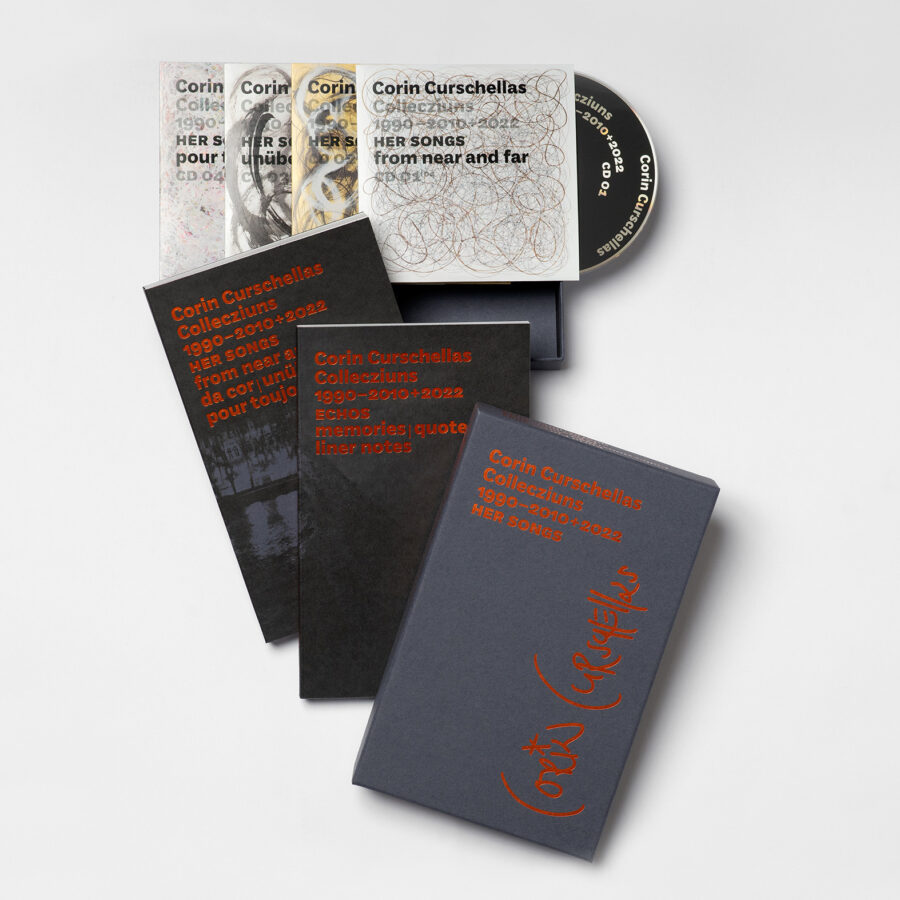
A colourful life calls for colourful colours — red, green, blue, yellow…, that’s how simple I thought at the beginning and researched numerous materials for the covering paper of the box and the two book covers. However, this seemed merely banal. Neither a natural elegance nor an atmosphere of preciousness could be achieved. In addition, many solid-coloured papers and cardboards show a one-dimensional solidity. They do not breathe, show no depth. [Promising ideas in the imagination usually fizzle out in the actual realisation, as is the case here…] Koehler’s fine dark grey cardboard Koehler® Eco Granite fulfilled both haptic and visual expectations as well as the criteria of environmentally friendly production and the required technical strengths.
Koehler’s fine dark grey cardboard Koehler® Eco Granite fulfilled both haptic and visual expectations as well as the criteria of environmentally friendly production and the required technical strengths.
Originally, the typography on the box and the book covers was to be in a subtle, matt orange-red colour. During production, however, it turned out that the hot foil stamping on the black LE-UV offset printing ink of the two photographs did not retain the required adhesion, opacity or edge definition. The final choice fell on a shiny orange metallic foil — only this surface and colour contrast transforms the small box into a precious and elegant casket and gives the books a harmonious solemnity.
You can read more about our new Koehler® Eco range of 8 colours inspired by nature’s beauty here.
The choice of paper for the core of the two books follows a pragmatic approach to craftsmanship: the eye-friendly white tone is a natural match for both the colour of the twine and the cover cardboard. The Munken Lynx Rough paper is excellent to print on, its surface is just as pleasant to the touch as the 1.4-volume.
Is there a reason behind the four chosen colours for the CD covers: pink, yellow, grey and blue?
The four CDs in the plain cardboard sleeves look like a miniature of the good old [and again current] vinyl LPs. Their packaging in anthracite-coloured cardboard with bright orange typography seemed too streamlined to me, even suffocating for the diversity and complexity of the musical spectrum that can be heard on them. It needed contrast and refraction here. That’s why the front pages each consist of a subject from the “Endless Pulsations” series and the colour backgrounds on the back are merely “colour extractions” from the respective front page.
The Cardboard sleeve is printed in 4/0-color CMYK offset and finished with matt dispersion varnish. The Swiss brochure is printed in 2/2-color offset LE-UV in Diamond screening, black highly pigmented and PANTONE 2028 U. Thread stitched with twine in orange red colour.
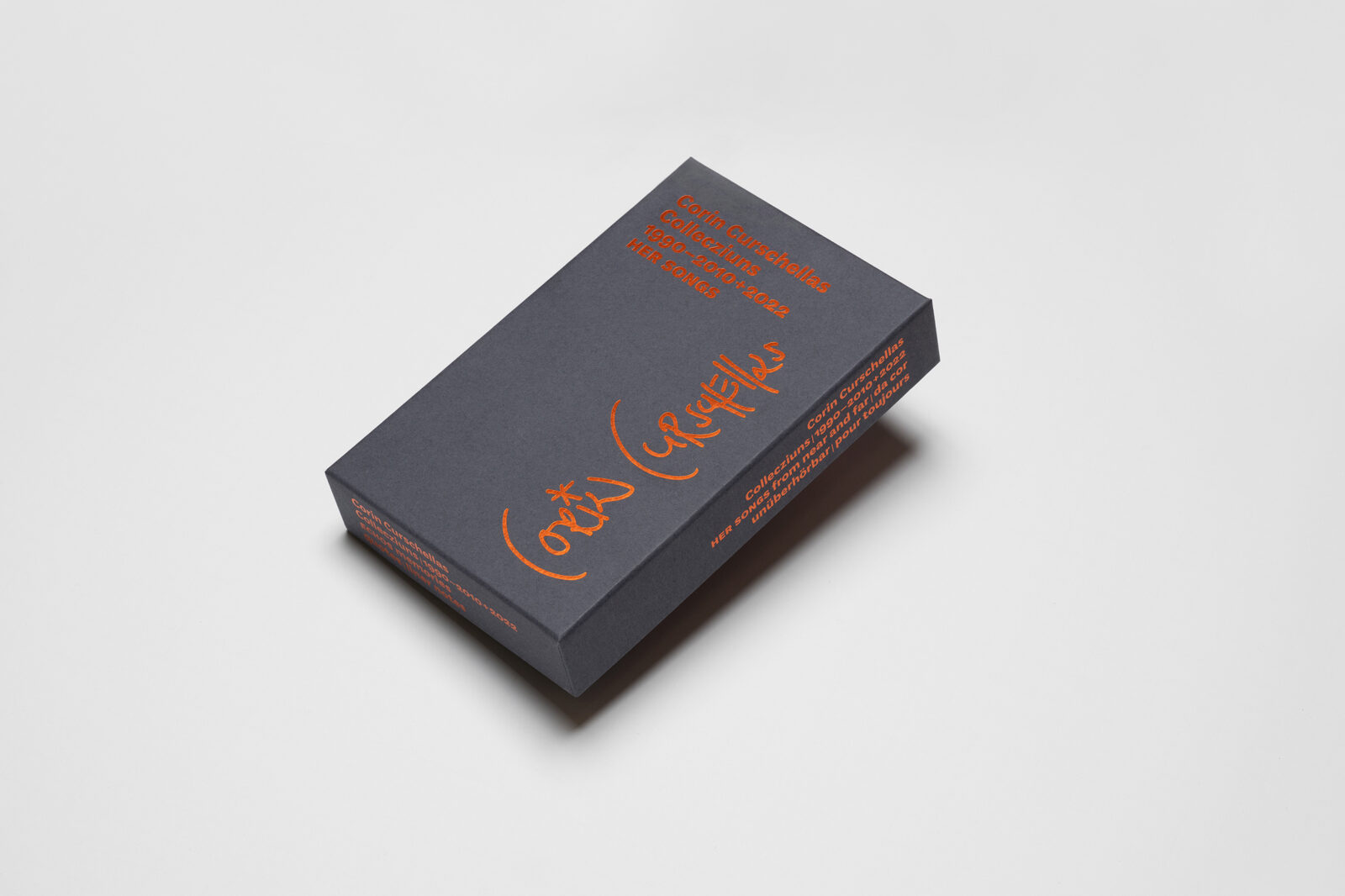
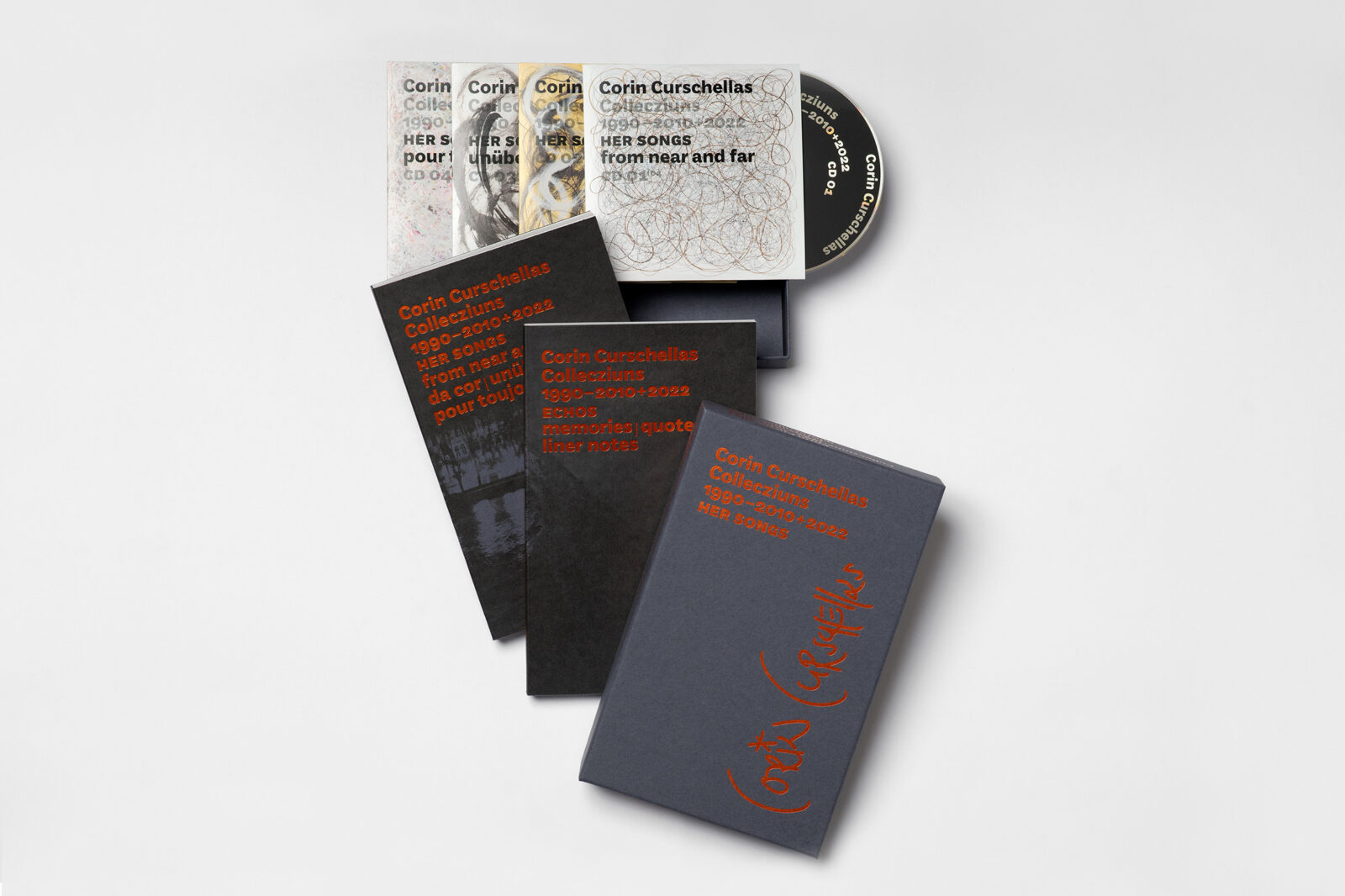
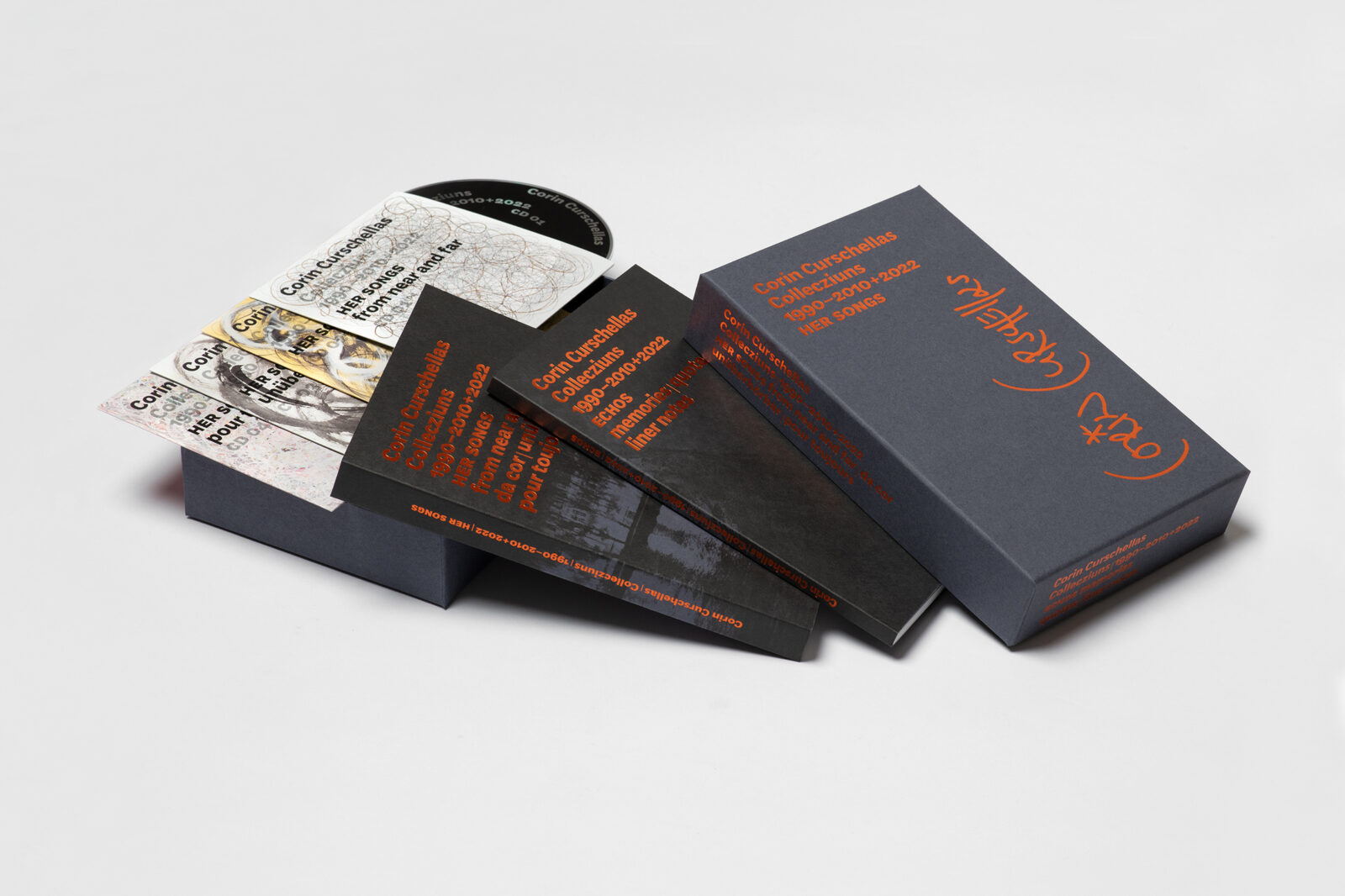
Remaining impressively fresh
Corin Curschellas’s music, which is up to 33 years old, jumps into your ears full of vitality and beguiles you with an unprecedented variety; “Music Loves Me” was the apt title of Corin Curschellas’ first solo album in 1992. Prior to this, she had mainly sung for other musicians such as Walter Lietha, Max Lässer, Bruno Spoerri and Andreas Vollenweider, until she was encouraged by those around her to present her own songs. “In the beginning, a lot of things happened to me by chance, by fate,” recalls Corin Curschellas. “I was basically open. And if there was something in the air or something appealing to me, I wanted to try it out. That’s how I came to the theater 50 years ago and had my first stage experiences.” This enduring openness and enthusiasm ultimately also explains the diversity and liveliness of her music.
